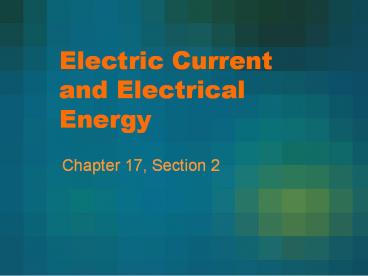Electric Current and Electrical Energy - PowerPoint PPT Presentation
1 / 6
Title:
Electric Current and Electrical Energy
Description:
Chapter 17, Section 2 Electric Current Electric current is the rate at which electric charges flow (electricity). The unit of current is the amp (A or I). – PowerPoint PPT presentation
Number of Views:277
Avg rating:3.0/5.0
Title: Electric Current and Electrical Energy
1
Electric Current and Electrical Energy
- Chapter 17, Section 2
2
- Electric Current
- Electric current is the rate at which electric
charges flow (electricity). - The unit of current is the amp (A or I).
- The higher the current, the greater the number of
charges that pass the point each second. - A. Making Charges Move
- Do charges in a battery instantly reach a light
bulb? NO! - The electric field causes the free electrons in
the wire to move. The energy of each electron is
transferred instantly to the next electron. - Commanding Electrons to Move
- This electric field is created so quickly that
all electrons start moving through the wire at
the same instant.
3
- AC and DC
- In direct current, the charges always flow in the
same direction. - In alternating current, the charges continually
shift from flowing in one direction to flowing in
the reverse direction.
4
- Voltage
- Voltage is the potential energy difference
between two points in a circuit. - The unit for voltage is the volt (V). Voltage
- Voltage causes current to flow through an
electric circuit. - Voltage and Energy
- The higher the voltage, the more energy is
released per charge. - Voltage and Electric Current
- The greater the voltage, the greater the current.
- A greater current means that more charges move in
the wire
5
- Resistance
- Current depends on more than just voltage.
- Current also depends on resistance.
- Resistance is the opposition to the flow of
electric charge. - The unit of resistance is the ohm (?).
- The greater the resistance, the less current
there is for a given voltage. - Thick wire less resistance
- Thin wire more resistance
- Better conductors less resistance
- Higher temperatures more resistance
- Paths of Least Resistance
- Electrons take the path of least resistance --
remember - electrons are lazy! If two paths are
available, they will flow through the one with
less resistance.
6
- Good conductors have low resistance, while
insulators have high resistance. - Resistance increases as temperature increases.
- Superconductors are materials where the
resistance is 0 ohms because it is so cold.

